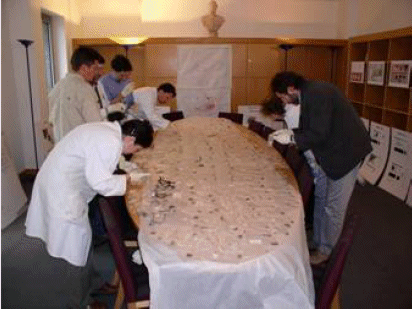A Guide to the Archaeology of Conflict
© T.L.Sutherland 2005
Introduction
This document contains a series of guidelines which are intended to assist a variety of individuals, from development control officers, land managers, prospective developers, archaeologists, to metal detectorists and other interested parties in assessing the impact of potential work on sites of historic battles or conflicts. Wherever possible, examples have been given in order to illustrate each concept. This document contains information and a series of proposals, which, if acted upon, will increase the potential evidence that can be acquired from a field of conflict.
This document is not written as a manual of how to carry out battlefield archaeology, but simply as a guide to the understanding of the discipline and the procedures that should be put in place if such sites are to be investigated or potentially disturbed. However, a case study from the Towton Battlefield Archaeological Survey Project is included so that an impression can be gained as to how such a project has developed.
Although many sites of conflict, which relate to standing structures and earthworks, for example Britain’s forts and castles, have been archaeologically excavated, this cannot be said of the sites of other engagements, such as battles. Consequently, it is only very recently that this aspect of military history has been substantiated using archaeological investigation (see Section 4).
 |
| Plate 1: |
Experts from the Royal Armouries, Leeds analyse some of the fifteenth century artefacts recovered as part of the Towton Battlefield Archaeological Survey |
The problem with many sites of conflicts is that actual remains of the event, the obvious physical heritage, rarely survive above ground. If archaeological evidence cannot be seen, it is less likely to be recorded and protected, as ‘popular’ heritage sites are generally those where the remains of the ‘site’ can be viewed. This failing is plainly exhibited in English Heritage’s ‘Conservation Bulletin of the Historic Environment’ (Dorn 2003, 7), entitled The Archaeology of Conflict. Of the 64 pages devoted to the topic, only one eighth of one page is devoted to battlefields themselves, that is, to the sites where conflict actually took place. The remainder of that document discusses Britain’s defensive sites, prisoner of war camps, cold war bunkers and airfields etc. Very few of these topics cover the physical remains of actual conflict. This example illustrates the problems associated with the archaeology of battlefields – they are rarely discussed because of their apparently vague and ephemeral nature. However, the contrary is true: battlefields are repositories of a vast amount of significant and virtually untapped historical information.
